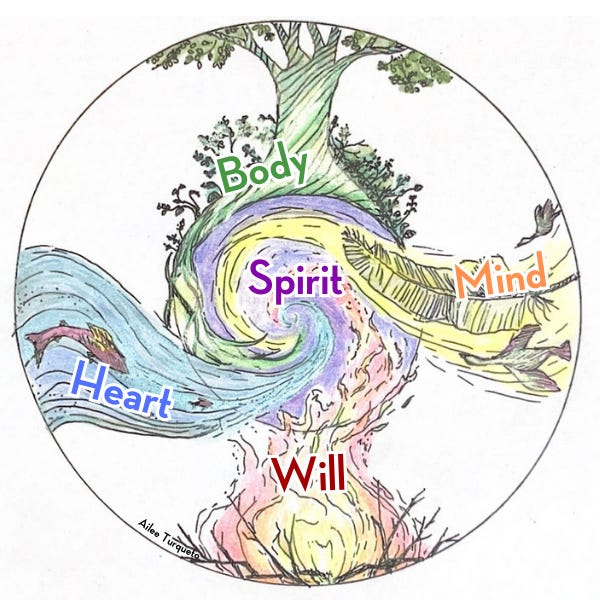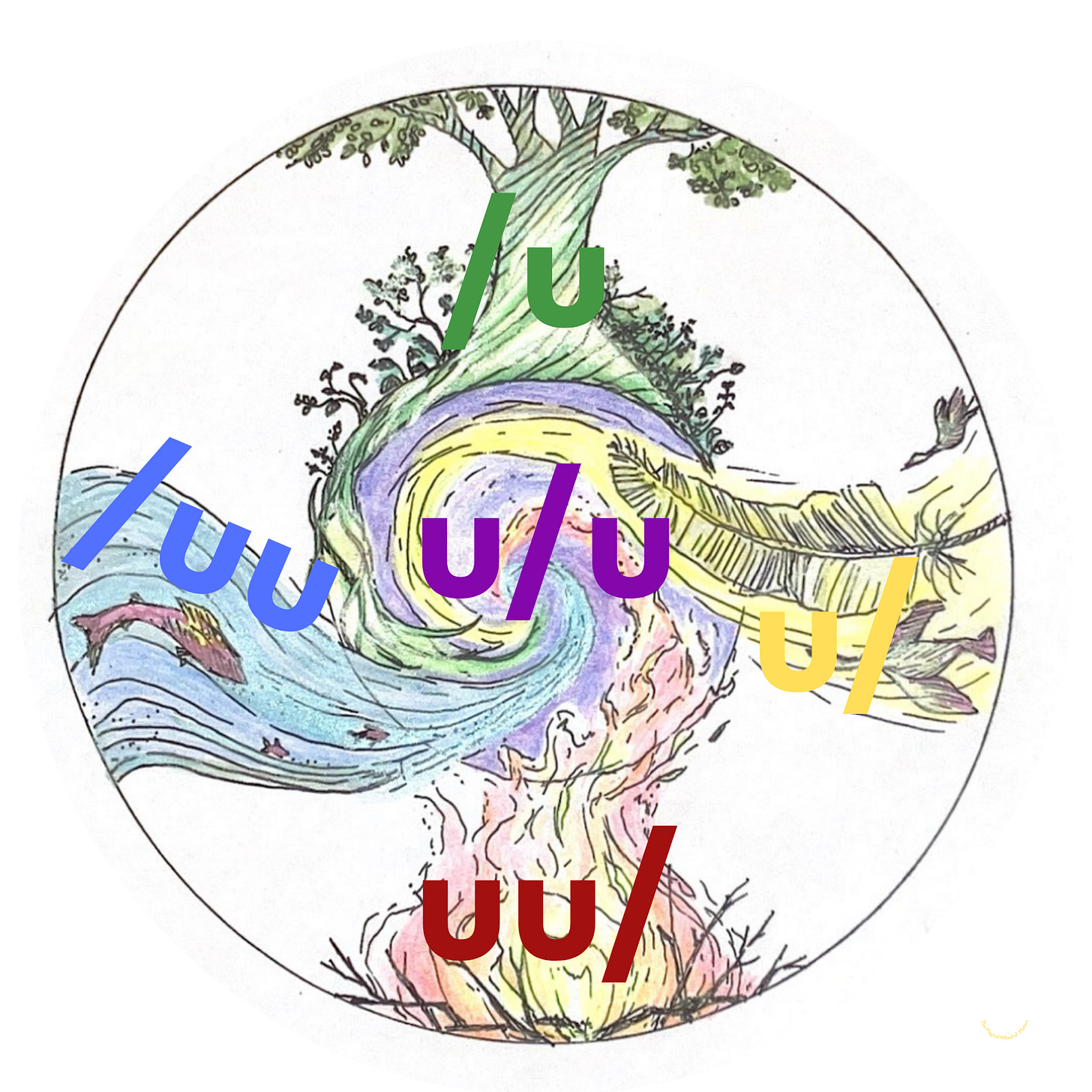Metrical Diversity, Scansion, En-Rhythming, The Metrical Code, and Five Directions
Find My Classes
Want to check it out? My central teaching home is classes.anniefinch.com
Five Useful Tools
These tools will orient you to some of the concepts on this site that I have developed over the course of my work, and which may be unfamiliar to you.
Metrical Diversity: Iambic pentameter isn’t enough.
Three-Step Scansion: The most effective system I know to scan meter in poems
En-Rhythming: How to bring meter into your words through your body.
Metrical Code: Decoding the deeper meanings of metrical words.
Five Directions: A magical, matriarchal approach to life, including ceremonial use of meter, based on the sacred circle of earth-based spirituality.
METRICAL DIVERSITY
I could (and am) writing a book about this phenomenally important idea, but it can be summarized in a couple of sentences. The vast majority of poems in English are written in one meter, iambic pentameter. This one-dimensionality impoverishes our poetry, our spirits, and our lives. And there is no reason it needs to be this way. More here
SCANSION: THREE-STEP METHOD
i consider the scansion of poetry (recognizing and marking its metrical patterns) to be, not only a deep sensual pleasure, but also a sacred art. Scansion is (along with dancing) one of the most attentive and reverent ways with which to open ourselves to the magical energy patterns that weave throughout poetry. It can also reveal hidden dimensions to the words we speak in the most meaningful moments of daily life.
Until the advent of free verse about a hundred years ago, poetic rhythm was so familiar in our bodies that scansion may not have been necessary. But —as I’ve learned over thousands of hours teaching meter—it’s a central tool for those of us who are serious about reclaiming the power of rhythmic language in our current world. Scansion can be a first step to navigating our way back into the body familiarity that guides much of the wisdom of oral-based, earth-centered societies. So scansion matters to the themes of this Spellsletter—poetry, magic, meter, feminism, and witchcraft. And some of my posts (such as this one on Yeats) will go into detail about meter and scansion.
For the huge numbers of us who were never taught scansion—or for those who were but not by me, and so are not familiar with my scansion terms— I offer this key. The six terms used here are my own inventions, developed through decades of scanning and teaching meter. Having invented these words due to the sore need for resonant, concrete nouns for basic scansion tools, I offer them freely to all who would like to adopt them (thought I would appreciate the courtesy of giving me credit for them—here’s looking at you, Masterclass!).
More on scansion, and metrical poems too, may be found on my Youtube channel. I have also released a small scansion workbook and am helping make a scansion app.
DEFINITION: “SCANSION,” “TO SCAN”
To mark the rhythmic patterns in a piece of writing (or spoken language). To reveal, recognize, understand, and experience metrical words in body and heart as well as mind. A magical tool to move deeper into the energy of language.
THE 3 BASIC SCANSION TOOLS
/ WAND
Marked above a stressed syllable—one that is louder, longer, and/or higher pitched than those immediately adjacent to it.
u CUP
Marked above an unstressed syllable—one that is softer, shorter, and/or lower pitched than those immediately adjacent to it.
| EDGE
Marked between (not above) groups of syllables. It indicates a footbreak—a division between repeating rhythmic units (commonly called “feet”), that are built on the same basic pattern of wands and cups.
THE 3-STEP SCANSION METHOD
(I learned this from Penelope Laurans, who learned it from Robert Fitzgerald)
Mark the wands
Mark the cups
Look for repeating patterns (“feet”) and mark the boundaries between them with edges
Name the line.
EXAMPLE
The sentence “It’s evening, and I call your name” would be scanned this way:
STEP 1 Mark the wands
/ / / /
It’s evening, and I call your name.
(Note: “I” may feel like a stronger syllable than “and,” but if you SAY IT ALOUD (the first rule of scansion!) you will notice that “and” needs to be spoken more strongly than “I.” Imagine shouting it to someone across a room to feel the difference. (Note 1: On a deeper level, if you are wondering how a small word like “and” can sound strong enough for a wand, the answer is that stress is relative: we hear a stress’s power relative to what’s around it. Because of the strength of the verb “call,” the “I” gets softer by comparison, and the “and” ends up being stronger than the two syllables next to it. Note 2: If you are wondering, “but what if I want to emphasize it differently? What if I want to stress the “I” because it is I, and not another person, who is calling?,” the answer is yes, you can do that (it’s called “performative stress”), but a reader seeing it on the page would not know you were doing it unless you changed the meter to make it happen. If you’d like to learn more about this, you’ll find it discussed in my book A Poet’s Ear.)
STEP 2 Next, add the cups
u / u / u / u /
I see you and I call your name.
Usually, a cup goes over each unwanded sylllable.
STEP 3 Finally, listen for repeating patterns and mark the edges
u / | u / | u / | u /
I see you and I call your name.
Looking for patterns, you will notice repetition: cup-wand-cup-wand-cup-wand etc.. Add the edges between them. If you are using a pen and paper, it helps to extend the edge right down between or through the words as needed. An edge is not used at the end of a line of poetry, because the linebreak serves the same purpose. For more complex lines, such as the ones I sometimes scan on this blog and discuss in the podcast, a scansion needs to show the variations in the basic meter.
STEP 4 To finish, name the pattern
The line has four feet with a u/ pattern, so it is an iambic tetrameter.
HOW TO NAME LINES Name the pattern you have revealed by combining the type of foot and the number of feet. The most common types of feet are the anapest (cup-cup-wand), iamb (cup-wand), trochee (wand-cup), and dactyl (wand-cup-cup. 2 feet is dimeter, 3 is trimeter, 4 is tetrameter, 5 is pentameter, 6 is hexameter. So lines are named things like anapestic tetrameter, dactylic hexameter, iambic pentameter, trochaic trimeter, and so on.
If a line has a significant variation, it is best to add that in the name as well (if the sample line above went
/ u | u / | u / | u /
Looking at you, I call your name
you would name it an “iambic tetrameter with a trochee in the first foot.”
ABOUT THE 3-STEP SCANSION METHOD: It forestalls the mind’s habit of imposing an expected pattern, forcing us to stay in our bodies and listen freshly for wands and cups each time we scan. [Learned in 1978 from my teacher, Penelope Laurans of Yale University, who adapted it from a method taught by her husband the poet and translator Robert Fitzgerald.] A video demonstration of the 3-step scansion method may be found on my Youtube channel.
3 LESS COMMON SCANSION TOOLS
\ HALF- WAND
Optional mark to indicate a stress whose intensity falls between a wand and a cup. Can be useful in resolving conflicts and moving forward, and in acknowledging special rhythmic effects. Use sparingly.
(u) GHOST CUP
Used to indicate something at the beginning or end of a line that doesn’t fit the expected pattern: either a missing cup at the beginning or end of a line, or an extra cup at the beginning or end of a line.
Example:
/ u | / u | / u | / (u )
Tyger, tyger, burning bright
If two syllables are missing, use a double ghost cup (uu).
# REST
Used to indicate a missing cup— a pause— in the middle of a line, where a ghost cup would be hard to see among the scansion marks.
THAT’S IT!
Now you know all you need to follow any of my posts or podcasts that involve scansion and meter!
Also feel free to check out my books including the Poetry Witch Workbook How to Scan a Poem (for the most detailed discussion!)….Also, A Poet’s Craft (in in-depth tome addressing scansion among many other aspects of poetry)., Calendars (which includes a free downloadable scansion guide ) and many other books. Videos about meter and scansion may be found on my youtube channel. Also check out my learning community, Meter Magic Spiral, and my list of upcoming classes, workshops, retreats and events here.
EN-RHYTHMING TECHNIQUE
En-rhythming is a term invented by one of my early students, a yoga teacher, to describe how I would coax a rhythm to enter my students’ bodies, bypassing their minds. I start by drumming and reciting poetry in the meter. after I while I stop reciting and continue drumming as they begin to write in the meter. Once they are in their metrical-writing groove, I taper off the drumming.
You can enprhythm on your own by any means that will introduce the meter into your body. You can drum, recite, listen to recordings of yourself reciting, stamp your feet, clap, dance, or simply meditate on a line or passage of poetry in your chosen meter.
Here are some tips:
— Choose a line or passage that sticks exactly to the base meter, without any variations from the basic pattern.
— Choose a line or passage you really love, so you will absorb it more easily.
— Plan to taper off the en-rhythming activity once you are in the groove, so you can focus entirely on your writing process. Once you are deeply familiar with a particular meter, you may find that you entrance yourself into the meter just by thinking of the meter itself.
— At first, use big pieces of paper (maybe from an artists’ sketchbook). You need pages that are wide enough to hold a full line of meter, so you won’t get confused about where the lines end.
— Stick with 3 or 4 feet of the meter to start (1-2 is too short to feel the groove, and 5-6 is too long to keep forward momentum)
— At first, write without stopping. Give yourself only one rule, to stick with the meter. Otherwise, give yourself complete permission to break all rules and defy all inhibitions. Allow yourself to be silly, to use cliches, to write complete nonsense, to repeat lines over and over, to feel pleasure, to be sentimental, to have fun.
Don’t change, fix, or revise anything. If you mess up, this may provide valuable information for you later (see “the metrical code” below). If you notice you’re off the meter, just adjust back into the meter as you move forward.
Enjoy!
THE METRICAL CODE
The Metrical Code is a system of decoding the deeper meanings of metrical words. Metrical meanings are by definition wordless, because meter is below and beyond words—and yet they involve words as well. The combination brings us into an ineffable realm where it is truly possible to experience the heart of a poem, where word and wordlessness dance without tension.
Throughout this blog, you will find posts that use the Metrical Code to understand how poems work in their most mysterious and powerful depths. If you search the tags “metrical code” and “deep scansion,” you will find them.
I first developed the idea of the Metrical Code as a graduate student in the early 1980’s, based on the semiotics of Roland Barthes in combination with versification and with feminist literary theory, and I have been living and working with it ever since. For more information, please see my book The Ghost of Meter: Culture and Prosody in American Free Verse where the concept was first, and most fully, developed. There is an update in an essay on the Metrical Code in my book The Body of Poetry: Culture and Prosody in American Free Verse, and story of how the idea developed is also told in the preface to How to Scan a Poem: A Poetry Witch Workbook. Finally, subscribers are free to ask me anything you like about the Metrical Code in the Comments!
FIVE DIRECTIONS
During over five decades of immersion in writing, memorizing, reciting, scanning, analyzing, and teaching metrical poetry—while simultaneously using meters in my ritual circles as a practicing witch— I have developed a system of associations between meters and human aspects/capacities that has proven useful for myself and for my students of poetry and magic. I call this system of correspondences the Five Metrical Directions.
Over the time I have been living and working with the Five Directions, like poets in oral-based, matriarchal cultures all over the world, I have allowed the meters to guide me towards a wider understanding of natural and cultural forces. In this way, I have shaped my fivefold path as a maker of poems, a shaper of systems of meaning, a keeper of natural magic, a community builder and teacher, and a performer of poetry and ritual, all in keeping with the energies of the Five Directions as channeled through the magic of their corresponding meters.
For readers of this Substack who are curious about how the Five Directions shape the musings on poetry and magic that I share here, you will find a brief overview below, and a link to a fuller esplication at the bottom. Each circle starts in the South (fire, will, at the bottom of the diagram) and moves counterclockwise (widdershins) through the forces of East, North, West, and Center.
Five Directions:
South: Fire/Red/Will/Passion
East: Air/Yellow/Mind/Understanding
North: Earth/Green/Body/Grounding
West: Water/Blue/Heart/Connection
Center: Matrix/Purple/Spirit/Magic
Five Metrical Directions:
South: Anapests/Will/Fire
East: Iambs/Mind/Air
North: Trochees/Body/Earth
West: Dactyls/Heart/Water
Center: Amphibrachs/Spirit/Matrix
I am currently writing about the Five Directions in several books and will update the information here as it is available. The Five Directions are the basis of much of my in-person teaching in my retreats and workshops, and my online teaching in my Meter Magic Spiral and, starting soon, through Randolph Lundine.
Find My Classes
Want to check out my teaching? I’d love to see you in one of my online classes. My central teaching home for those is classes.anniefinch.com
I also teach offer other kinds of teaching, from private consultations to workshops on poetry and magic to small-group retreats in amazing places. To check those out, please visit my website where you can see a calendar and also subscribe to my Spellsletter for inspiration and news.






